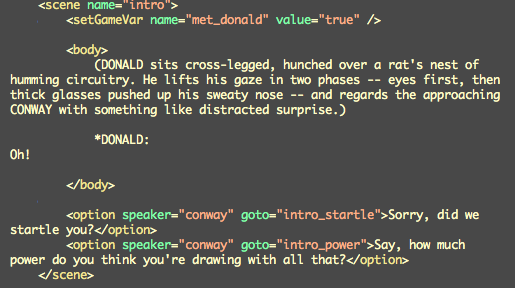Hi y'all! This month's newsletter is a two-parter. In the first part, I (Jake) am going to tell you a bit about my process writing dialog for the game. In the second part, sometime early-mid next week, Tamas is going to give you an overview of his process producing the 3D models and environments.
About a year ago I made a short game called
Hummingbird Mind
, and in that process I came up with a really simple codebase for multiple-choice game dialog. I've been schlepping that code around from project to project, but for Kentucky Route Zero I took the same basic system but rewrote it to be a bit smarter in the way it lays out the text (mostly in order to match the visual style of theatre manuscripts). My process when making dialog- or text-heavy games has always been to come up with some kind of extended text format that I can just sit and write into -- I do a lot of programming up front so I can just focus on writing without distraction.
Here's a bit of what the text I'm writing looks like while I'm writing it:

Even if you're not a programmer, you can probably get the gist of what's happening here. I try to keep the system pretty minimal and braindead, so I don't have to switch gears from creative writing to programming too much while I'm working. As you'll notice, the "<option>" items in that snippet have a special attribute called "speaker". That's because some dialog options are only available when certain companions are accompanying you. Since Conway can only have two companions with him at a time, an important part of the game will be deciding who to bring along when talking to whom.
If you're interested in digging into this further, I used an earlier version of this system in my game Balloon Diaspora, and you can find the full
source code on github
.
cya next week!